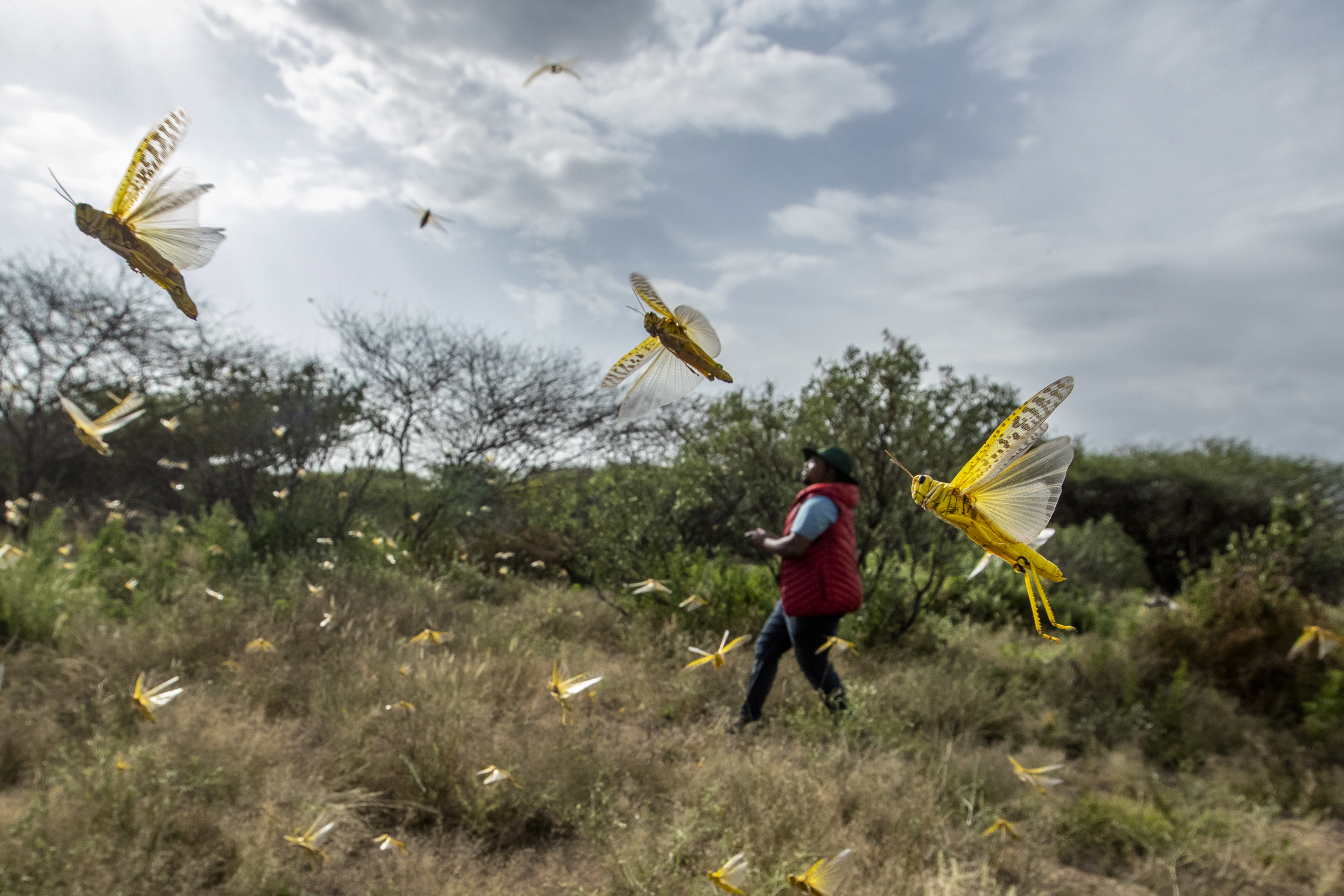
In this photo taken Saturday, Feb. 1, 2020, desert locusts jump up from the ground and fly away as a cameraman walks past, in Nasuulu Conservancy, northern Kenya. As locusts by the billions descend on parts of Kenya in the worst outbreak in 70 years, small planes are flying low over affected areas to spray pesticides in what experts call the only effective control. (AP Photo/Ben Curtis)
Rwanda will be on the alert to avert any possible invasion of dessert locusts which are now reported in Northern Uganda.
According to reports in Ugandan media, swarms of the deadly desert locusts entered Uganda on Sunday through the north eastern part of Amudat District, located in Karamoja region.
The invasion of the locusts which has ravaged northern parts of Kenya has caused panic in the region, leading the fears that they could spread further to Rwanda and other parts of the great lakes, ravaging crops and vegetation.
Rwandan agricultural officials however, believe that chances for Rwanda to be affected are still minimum given their history in the region.
“The locusts’ threat last affected Rwanda several decades ago. Right now, they are still far away from us. If you look at the movement pattern of these locust swarms, you note that normally they first eat up an area before they move on,” Dr Patrick Karangwa, Director-General of Rwanda Agriculture Board (RAB) told the media on Monday.
Karangwa further said, that the country is counting on the usual collaboration with farmers and relevant institutions to fight desert locusts attack if any.
“They always attacked the Horn of Africa region and not come up to Rwanda. There is a good probability they will not get here but this does not mean that we rest on our laurels. As is always the case, our institutions are ready and are collaborating to do whatever is necessary in case of an attack,” Dr. Karangwa said adding that earlier preparation is the way to go.
The outbreak of locusts in the region has caused pandemonium in the region, with social media videos showing the deadly insects invading gardens in Kenya and Ethiopia.
Experts warn that the low flying insects which attack in their millions cannot be eaten or dealt with without proper planning and could cause hunger in the near future if not dealt with.
Since December last year, the insects have destroyed crops worth millions in North Western Kenya and have also left destruction in their path in Ethiopia, Somalia and now Uganda.
Last month, the Minister of Agriculture and Animal Resources, Geraldine Mukeshimana, said that the country was ready to deal with the locust threat.
Food and Agriculture Organization (FAO) warned last year that desert locusts would spread to other Eastern Africa countries including Djibouti, Eritrea, Kenya, Uganda and South Sudan if not averted.
The UN body in the latest brief said breeding of locusts continues in the Horn of Africa, which will cause locusts to increase further in Ethiopia, Somalia and Kenya with new swarms forming in March and April.
“Consequently, there is an unprecedented threat to food security and livelihoods in the region,” the FAO Dessert Locust Watch said last week.
“In Kenya, numerous immature and mature swarms continue to move throughout northern and central areas. Mature swarms reached within 50 km of the Uganda border on 6 February and other mature swarms nearly reached the Tanzania border on the 7th,” it added.
FAO further said that widespread egg laying and hatching have started, and so far numerous dense early instar hopper bands are present in some central areas. Aerial and ground control operations are continuing.
On 9 February, there were reports that Desert Locust arrived in northeast Uganda near Amudat (0157N/3456E). Other reports indicated that Desert Locust had crossed the border into northern Tanzania close to Mt. Kilimanjaro, reaching Arusha and Mushi.
In Somalia, second to fourth instar hopper bands are present in the northeast near Garowe. Other infestations are likely to be present in the northwest, central and southern areas where breeding is expected to be in progress.
In Ethiopia, maturing swarms were present in eastern and southern areas and additional swarms moved into the Rift Valley from the south and the north.
“Egg-laying and hatching are likely to be underway but so far it has not been detected. Aerial and ground control operations continue in most areas,” FAO said.
According to FAO, widespread hatching and band formation will occur in the coming weeks in Kenya, Ethiopia and Somalia.
There remains a risk of a few small swarms appearing in northeast Uganda, southeast South Sudan and perhaps northern Tanzania in the coming days. It however doesn’t mention Rwanda.
Experts say the locusts are low flying and can’t handle high altitude mountains and hills but parts of Rwanda, particularly the Eastern and Southern Province with undulating terrain remain susceptible.
An average swarm can destroy crops that could feed 2,500 people for a year, FAO said. A desert locust swarm can be 460 square miles in size and pack between 40 and 80 million insects into less than half a square mile.
Each locust can eat its weight in plants each day, so a swarm of such size would eat 423 million pounds of plants daily.
Experts further warn that eating them alone cannot be a solution, given their sheer numbers but they are a rich source of protein.

